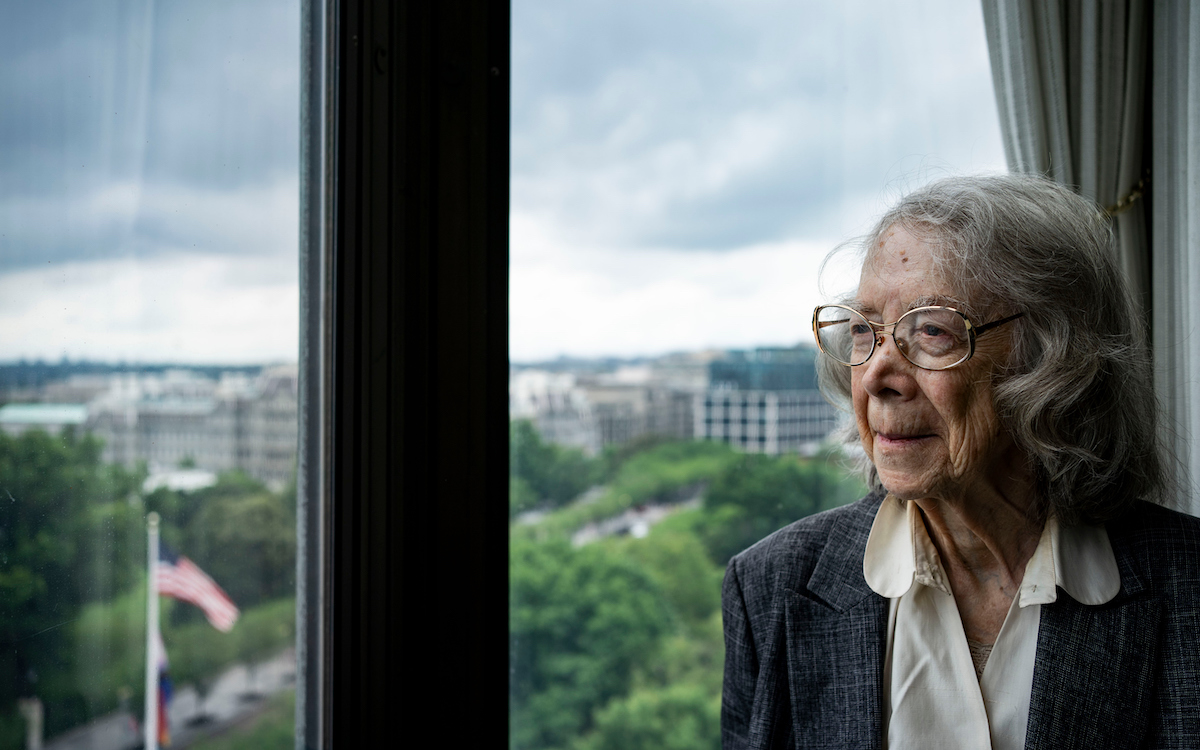“Bury the lead!” is certainly unusual editorial advice but possibly the only good strategy for an essay on the vagaries of the federal court system. You never want your readers to know that they might find the subject matter of your essay less than exciting. But you’re now reading the rare article on the United States Court of Appeals for the Federal Circuit that promises that this court really is interesting—or at least can be. There probably aren’t many readers who’ve even heard of it. But the court’s judges’ chambers, which overlook the White House, are now the setting of an unprecedented controversy that has prompted one of the country’s most well-respected judges to pen an equally unprecedented open letter to the Wall Street Journal criticizing her colleagues. Depending on how the controversy plays out, it could represent a significant afront to our constitutional system and the rule of law.
Depending on how you count them, there are five federal courthouses in Washington, D.C. Lawyers for Judge Pauline Newman of the Federal Circuit were just over a mile from her chambers when on June 27 of this year they filed a lawsuit in a federal trial court on her behalf against Chief Judge Kimberly Moore and two other Federal Circuit judges, seeking to have Judge Newman’s judicial duties reinstated. The complaint asserts that when her efforts to convince Judge Newman to retire were unsuccessful, Chief Judge Moore then turned to administrative mechanisms outlined in the 1980 Judicial Conduct and Disability Act to deny Judge Newman who, at 96, is the oldest active judge in the entire federal judiciary, the ability to perform her judicial duties. Judge Newman has asked the district court both to reinstate her to her judicial duties and to find that the Act is, at least in part, unconstitutional.
There are competing theories as to why the chief judge wants Newman off the bench. One is that Newman is “totally disabled physically, and mentally incompetent.” Chief Judge Moore’s order. dated March 24, 2023, claims that she has “probable cause to believe that Judge Newman’s health has left her without the capacity to perform the work of an active judge” and that her presence on the court is “prejudicial to the efficient administration of justice.” Judge Newman, however, has produced significant evidence that is readily available to the public that she is in fact fit to discharge her judicial duties. Her own physician, a George Washington University neurologist, affirms her mental competency for the job. And experts in the complex fields that make up the Federal Circuit’s jurisdiction, including the former chief judge of the court, confirm that there has been no perceptible decline in the quality, volume, or incisiveness of Newman’s published opinions. The complaints against her, Newman says, are based on “most extraordinary fabrications and exaggerations.”
Clearly, Newman is not taking any of this lying down. The dueling orders, letters, and motions pertaining to proceedings are all available on the Federal Circuit’s website. Newman has even granted interviews (here and here) to the press. She has her own theories as to why the chief judge and other colleagues want her off the court. It is possible that the chief judge wants to create an opening for a presidential appointment, but Newman—by this time at the center of a barely contained constitutional crisis—isn’t buying it.
The U.S. Court of Appeals for the Federal Circuit was created in 1982 by the merger of a few preexisting courts. It has a unique but important jurisdiction that includes most issues relating to trademarks, copyrights, and patents. This is not the venue where culture war battles play out. There are no traditional “left and right” dividing lines on this court. It is a near impossibility that the Federal Circuit would ever be faced with questions relating to civil rights. It is, rather, where judges wrestle with some of the most complex and difficult legal questions in the entire field. It is a vitally important court for the protection of private property, both because of its jurisdiction over intellectual property matters and its adjudication of issues relating to government takings. Almost all the judges have training as engineers and scientists in addition to legal training. Judge Newman, the first direct appointee to the court, is no different. She graduated from New York University School of Law only after completing a Ph.D. in chemistry at Yale and spending several years as a research scientist. She holds several patents herself that date back to that time in her career. Chief Judge Moore herself is an MIT-trained engineer.
Newman believes she has become the target of her colleagues’ attention because they “are tired of being told that they’re not perfect.” Her frequent dissents demonstrate an “understanding of … law [that] conflicts with that of many of her colleagues.” Without her dissents, the workload of Federal Circuit judges would decrease by 5%.
The subject matter of most of the Federal Circuit’s docket is so complex that even most attorneys have difficulty parsing it. Applying the law to complex and specialized scientific, medical, and technological questions requires a level of expertise in extra-legal fields that only specialized attorneys have. And the rulings of the Federal Circuit on these questions often become the law of the land, since so few cases are ever appealed to the Supreme Court and its unique subject matter jurisdiction means that a circuit split on many of these issues is not possible. Newman has, in fact, established herself as “an intellectual powerhouse” and is the author of majority opinions in some of her field’s seminal cases. She has also provided the intellectual framework through her frequent dissents for many other seminal cases when the Federal Circuit has been overturned by the Supreme Court. One judge has even noted that “Judge Newman is particularly well-known for her insightful dissents, which have often been vindicated by the Supreme Court” when it has “adopt[ed] essentially the reasoning of [her] dissent.” The judge affirming Newman’s stature and the value of her dissents? Chief Judge Kimberly Moore.
Judge Newman concedes that her reputation is already tarnished but has resisted the pressure to retire on principle. “If the judges on a court can just vote out someone they don’t like, for whatever reason … that’s not what the nation is entitled to.” Moore has assigned herself and two other judges to a committee to investigate a complaint regarding Newman’s fitness that the chief judge herself initiated. The focus of that investigation has morphed from questions about Newman’s fitness into disciplinary issues owing to Newman’s refusal to comply with the committee’s order to submit to a medical evaluation, despite having submitted a report from her own physician. So, in short: Chief Judge Moore herself filed the judicial equivalent of an HR complaint against Judge Newman. And then Moore appointed herself to the committee that is investigating her own complaint. And when Newman objected not only to the substance of the complaint but to the process of investigating it as well, Moore—as prosecutor, judge, and jury—took disciplinary action against Newman by suspending her from her judicial duties “with no time limit and with little heed for the regulations and case law.”
Federal judges enjoy lifetime tenure “during good behavior.” Once appointed by the president and confirmed by the Senate, these judges can only be removed from office via impeachment by Congress. This system was devised to insulate judges from political or popular influence. In 1937, frustrated with life-tenured Supreme Court justices standing in the way of New Deal legislation, President Franklin D. Roosevelt proposed a court-packing plan that would place justices on the court who would be more receptive to his political project. A similar scheme was floated again in 2021 as progressives anticipated the vulnerability of decisions key to political priorities like Roe v. Wade and Regents of the University of California v. Bakke, both of which have subsequently been overturned. The rule of law depends on the stability of the justice system, and the stability of the justice system depends on constancy and the apolitical nature of the courts. This is why it is not easy to remove a federal judge or to subject him or her to the political pressures that elected officials endure (and often apply).
No matter the motivation behind the actions of Judge Newman’s colleagues on the Federal Circuit, they have certainly denied her any semblance of due process. Potential jurors are excluded from juries when they have personal knowledge of events relevant to the trial—an eyewitness to a crime would never be allowed to serve as a juror in the prosecution of one accused of perpetrating it. And no person standing to lose or gain from a particular outcome of a trial could serve, either. Yet the members of the judicial council of the Federal Circuit sit like jurors determining Judge Newman’s fate despite clear conflicts that would justify excluding them from a jury sitting to consider a similar case. They have also done violence to the notion of the separation of powers spelled out in the U.S. Constitution. It is only Congress that can remove a federal judge from office through its impeachment power.
The independence of the judiciary is an innovation of the American constitutional order and has proved to be a largely effective safeguard for liberty. The system is not without flaws, but the judiciary has endured as an apolitical institution. The Constitution assigns distinct responsibility to two political actors—the president and senators—for the makeup of the federal judiciary. The fact that their elections almost always involve the discussion of judicial appointments is proof that at least the formal structure of the system has been preserved. The attempts to sidestep it through court-packing have been defeated. But if judges themselves can exert the type of pressure that has been placed on Judge Newman, the system will be compromised.
Despite procedural and due process concerns, the actions of the chief judge of the Federal Circuit have proceeded under color of statutory law, which Newman convincingly argues is unconstitutional. Newman’s service has been exemplary, and she is universally respected. The mark that this leaves on her record is tragic. But it may very well be that the greatest debt the nation owes to her is that she has resisted an unfair and (likely) unconstitutional effort to exclude her from office. We should all hope that the courts or Congress vindicate her—not only for the sake of justice but also because in so doing they will be vindicating and preserving our constitutional order and the rule of law.

